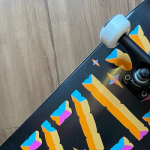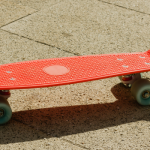Skateboarding is more than just a sport – it’s a global cultural phenomenon that has taken the world by storm. And at the center of every skateboard is its core component – the deck.
The skateboard deck is where riders showcase their skills and pull off amazing tricks, making it a vital part of the whole skateboarding experience.
In this article, we’ll dive into the fascinating world of skateboard deck manufacturing, exploring the materials, techniques, and craftsmanship that go into crafting these iconic boards. So, let’s get rolling.
Materials Used in Skateboard Deck Construction
Skateboard deck construction involves a thoughtful selection of materials to ensure a perfect balance of durability, flexibility, and performance. The following materials play a crucial role in the construction of skateboard decks:
Wood Selection:
The primary material used for skateboard decks is wood, with the most commonly used type being maple.
Maple wood is favored for its exceptional strength, durability, and flexibility, making it an ideal choice for skateboard manufacturing.
Manufacturers typically use a combination of several thin layers, known as veneers, to create a sturdy yet pliable deck.
These veneers are carefully selected and bonded together, ensuring optimal performance and longevity.
While seven-ply decks are the industry standard, some manufacturers may experiment with different ply configurations to achieve specific characteristics, such as added rigidity or increased responsiveness.
The careful craftsmanship and attention to detail in the construction of skateboard decks contribute to the overall quality and performance of the skateboard.
Maple Veneers:
Maple veneers, renowned for their exceptional quality, are meticulously sourced from hard rock maple trees predominantly cultivated in North America.
These trees are specifically chosen for their robustness and remarkable fine grain structure, which imparts an ideal amalgamation of strength and flexibility to the wood.
In order to ensure the utmost perfection, each veneer undergoes a meticulous inspection process to identify and eliminate any imperfections before being delicately laminated together.
This rigorous attention to detail guarantees the production of top-notch maple veneers that are not only visually stunning but also possess outstanding durability.
Skateboard Deck Manufacturing Process:
Once the materials are carefully selected and prepared, the production process moves forward to shaping, pressing, and finishing.
Veneer Preparation:
- Initiation: The manufacturing process begins with the preparation of maple veneers, which are approximately 1/16th of an inch thick.
- Layering: Manufacturers meticulously stack these veneers on top of each other, ensuring that the wood grains of adjacent layers run perpendicular to one another.
- Purpose: This cross-grain construction isn’t merely a technical detail; it’s a crucial aspect that enhances the deck’s overall strength and acts as a preventive measure against warping.
Gluing and Pressing:
- Application of Glue: The stacked veneers undergo a coating process with a high-strength glue.
- Cold Pressing: The glued veneers are then subjected to a hydraulic press in a process known as cold pressing.
- Bonding: This process applies immense pressure to bond the veneers into a solid deck, ensuring a tight and durable connection between the layers.
- Curing: The deck remains in the press for a specific duration, allowing the glue to cure and form a robust, cohesive structure.
Mold Shaping:
- Post-Pressing Process: Once the deck has been successfully pressed, it is removed from the press.
- Trimming: The deck is then meticulously trimmed into the desired shape using a template or mold.
- Mold Influence: The mold dictates crucial features such as concave (the upward curve along the edges), kicktails, and the overall shape of the deck.
- Function of Concave: The concave shape significantly enhances control and responsiveness, particularly during the execution of tricks.
CNC Machining:
- Advanced Technology: In select manufacturing facilities, computer numerical control (CNC) machining is employed for precision.
- Cutting and Shaping: CNC technology allows for highly accurate cutting and shaping of the deck according to specific design specifications.
- Consistency: This technology ensures consistency in deck production, contributing to both accuracy and uniformity across different boards.
Drilling Holes:
- Final Step: Holes are drilled into the deck, specifically for attaching trucks—the metal components responsible for holding the wheels.
- Strategic Placement: The placement of these holes is a critical factor in achieving the right balance and maneuverability for the skateboard.
Deck Graphics Application:
- Post-Shaping Process: After the deck is shaped and the necessary holes are drilled, it proceeds to the graphic application stage.
- Graphic Techniques: Skateboard decks are renowned for their vibrant graphics, applied using various techniques such as screen printing, heat transfer, or digital printing.
- Aesthetic Considerations: Manufacturers carefully consider aesthetic appeal, ensuring that the chosen graphics complement the brand and style. Importantly, the graphic application should not compromise the structural integrity of the deck.
Lamination:
- Protective Layer: To safeguard the graphics and enhance overall durability, a layer of clear laminate is applied over the deck.
- Material: This laminate is typically made of materials like fiberglass or other composite materials, adding an extra layer of strength to the deck.
- Visual Clarity: Despite the protective layer, the clear laminate allows the graphics to shine through, maintaining the visual appeal of the deck.
Quality Control:
- Inspection Process: Quality control becomes a focal point at this stage. Each deck undergoes a thorough inspection to ensure it aligns with the manufacturer’s standards.
- Defect Checking: Inspectors carefully check for defects, delamination issues, and ensure proper shaping according to specifications.
- Sorting: Decks that pass inspection proceed to the finishing stages, while any identified imperfections are addressed or discarded.
Finishing:
- Sanding: The final finishing touches involve meticulous sanding of the edges and surface of the deck. This process ensures a smooth and polished appearance.
- Irregularity Removal: Any excess laminate or irregularities are carefully removed during the sanding process, contributing to the deck’s refined finish.
- Optional Clear Coat or Sealant: Some manufacturers choose to apply a clear coat or sealant at this stage. This additional layer protects the deck from environmental factors and further enhances its longevity.
By following this systematic progression, skateboard manufacturers can produce decks that not only meet quality standards but also offer optimal performance and durability for riders. Each step plays a vital role in crafting a skateboard deck that is both functional and responsive to the demands of the skating community.
Conclusion:
The skateboard deck manufacturing process is a blend of precision, skill, and attention to detail.
From the selection and preparation of materials to the final finishing touches, each step plays a crucial role in creating high-quality decks that meet the needs and expectations of skateboarders worldwide.
With advancements in technology and constant innovation, the manufacturing process continues to evolve, resulting in even stronger and more durable skateboard decks.
As the demand for skateboarding grows, manufacturers continue to push the boundaries and improve their processes, ensuring that riders have access to top-quality decks that allow them to reach new heights in their skating journey.
![Why do skateboarders hate scooters? [Reasons + Tips] Why do skateboarders hate scooters? [Reasons + Tips]](https://bedoper.site/wp-content/uploads/2023/04/Why-do-skateboarders-hate-scooters-150x150.png)


![How fast do skateboards go downhill? [90 mph (145 km/h)] How fast do skateboards go downhill? [90 mph (145 km/h)]](https://bedoper.site/wp-content/uploads/2023/04/How-fast-do-skateboards-go-downhill-150x150.png)
